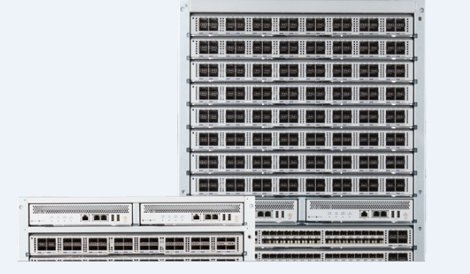Arista Networks, the company that aims to take down the networking stalwarts like Cisco using what it claims is a “true” open approach, is plugging a gap in the market with a new series of switches designed to work on its Spline (combination of leaf and spine) network architecture.
The 7000 X Series switches are targeted at networks requiring both volume and a modular approach to host connectivity, and have been designed to replace Cisco’s “aging” Catalyst 6500 switches, Arista VP of systems engineering Doug Gourlay said.
The company’s Spline network architecture, which Arista said is a two-tier leaf-spine design originally based on its 7500E and 7x50 Series, can now be used by these switches to offer more high-density options to cater for the growing need for scale out operations involving big data and other tasks.
Spline collapses the leaf and spine together into a single-tier network, which Gourlay said allows for better latency and network performance, while reducing operating costs by about 40%.
Artista claims it can bring about deterministic performance for up to 2,000 hosts in one cluster.
“The new 7300 switches, for example, can address almost 70% of the world’s data center market because they cater for data centers that are below 2,000 servers,” Gourlay said.
“With the 7000 and 7250 it means you can now scale from eight server rooms to the 100MW data center.”
The Arista 7000 X series includes Arista’s EOS Linux-based operating system which allows for automatic provisioning, smart systems upgrades using F5 and network orchestration and provisioning using tools from OpenStack.
The 7300X switch series comes with three chassis – the Arista 7304, 7308 and 7316 with 4,8 and 16 line card slots. They can scale form 512 ports of 40GbE, or 2,048 ports of 10GbE with wire-speed performance of 40Tbps.
Arista said that two of its 7316 Series systems can fit in one 42RU rack supporting more than 4,000 10GbE ports. Each has under 3W per 10GbE port and latency of under 2 microseconds, meaning a pair of 7300 series switches can replace two Catalyst 6509Es “with more than ten times the scale, throughput, latency improvement and power efficiency”.
“Our goal is to give our customers a much more linear pricing model – lower price of networking, improved velocity of service delivery, without building proprietary architectures,” Gourlay said.
The Arista 7250X Series has been built for the high-density deployments Gourlay said Arista is seeing increase across the networking space.
It has 64 ports of wire-speed 40GbE – or up to 256 Ports of 10GbE in a two-rack unit fixed form.
Both switch series offer Layer2 MAC Table and Layer 3 routing tables that can dynamically expand to support up to 288K MAC entries or 144K routes.
They also have duplex fiber 40GbE optics, network telemetry for real-time visibility into network congestion and include Arista’s VMTracer provisioning and VXLAN support.
The 7300X series will have a pricing start point of £350 per 10GbE port and will be available from Q4 this year.

